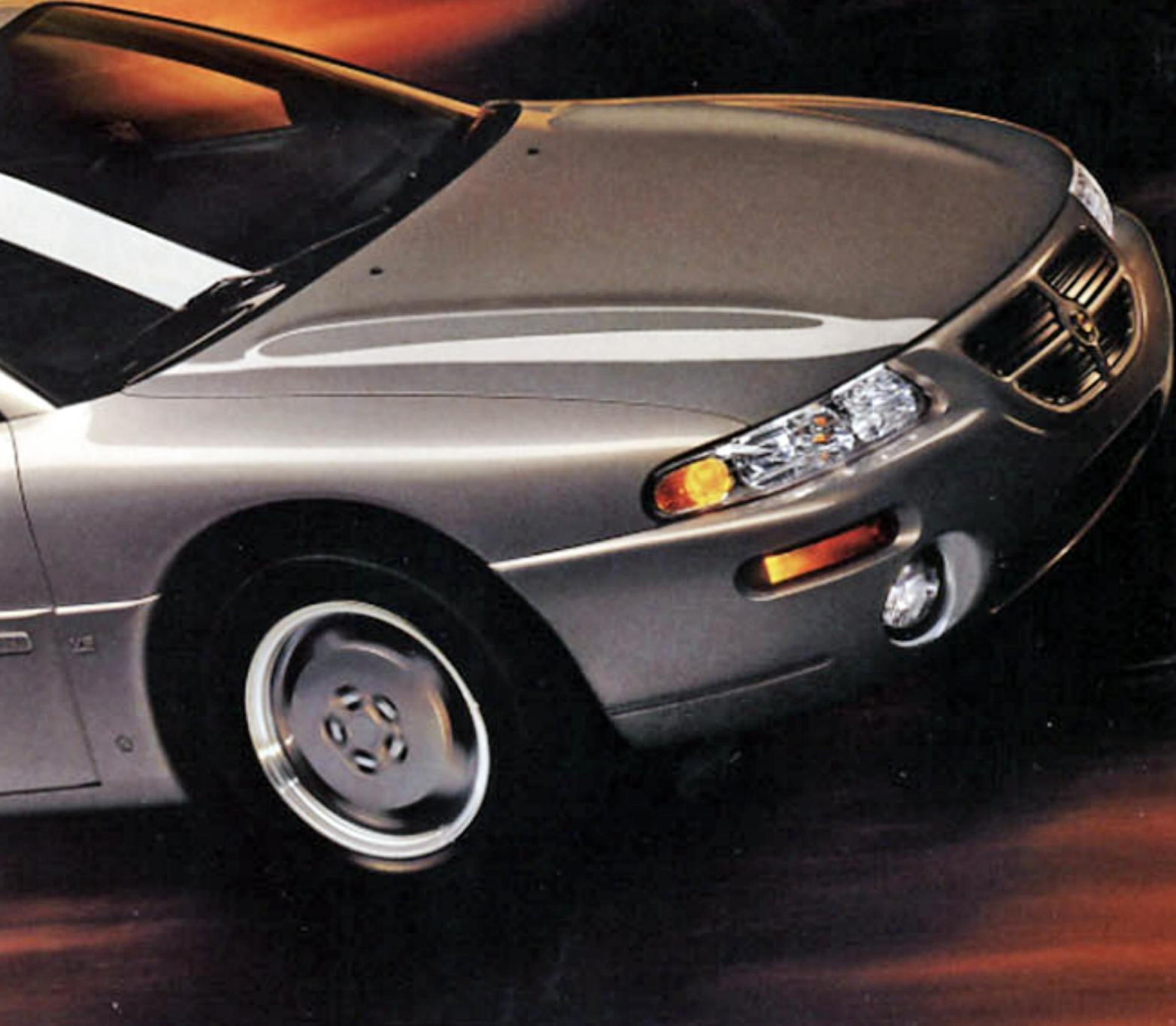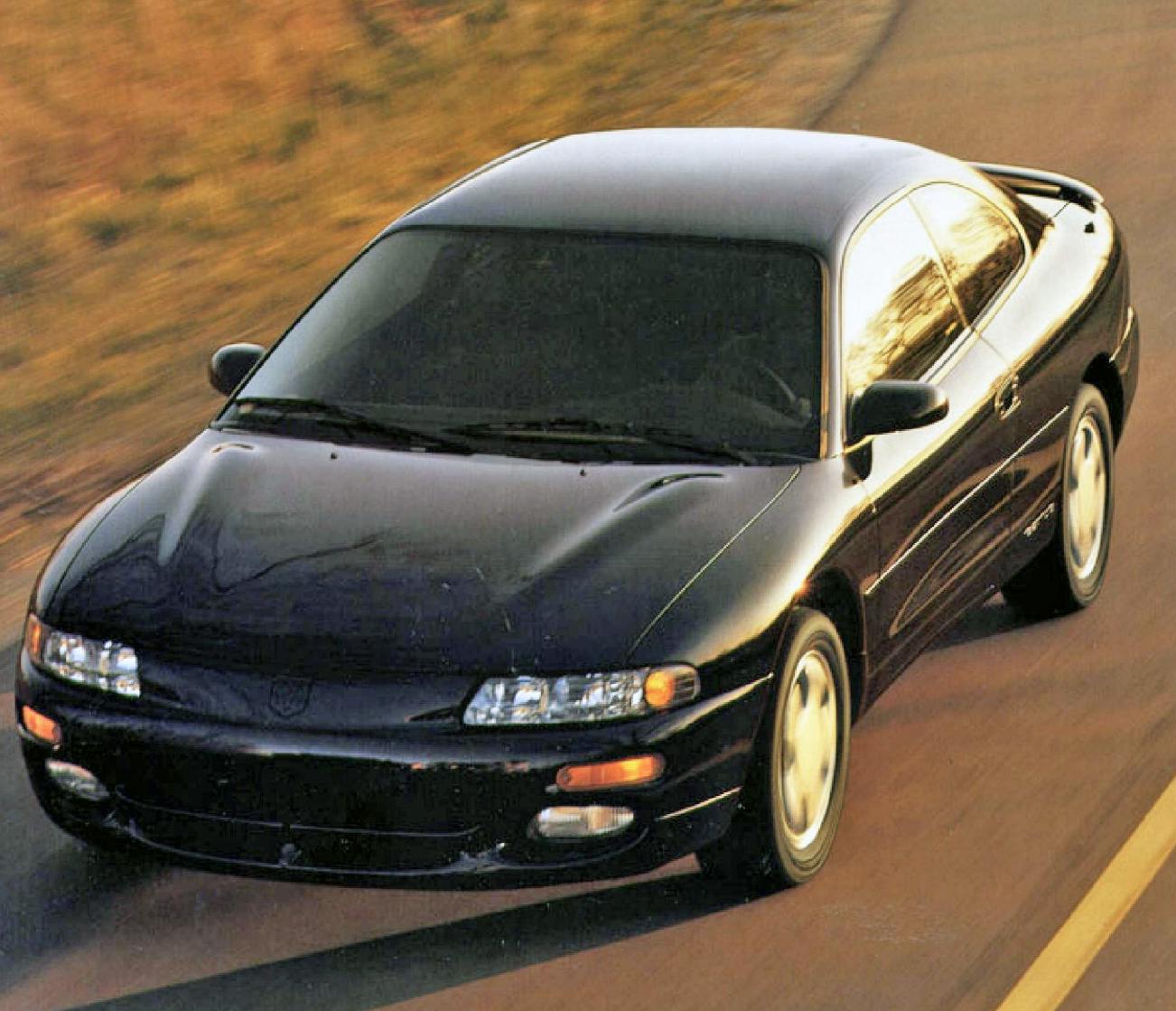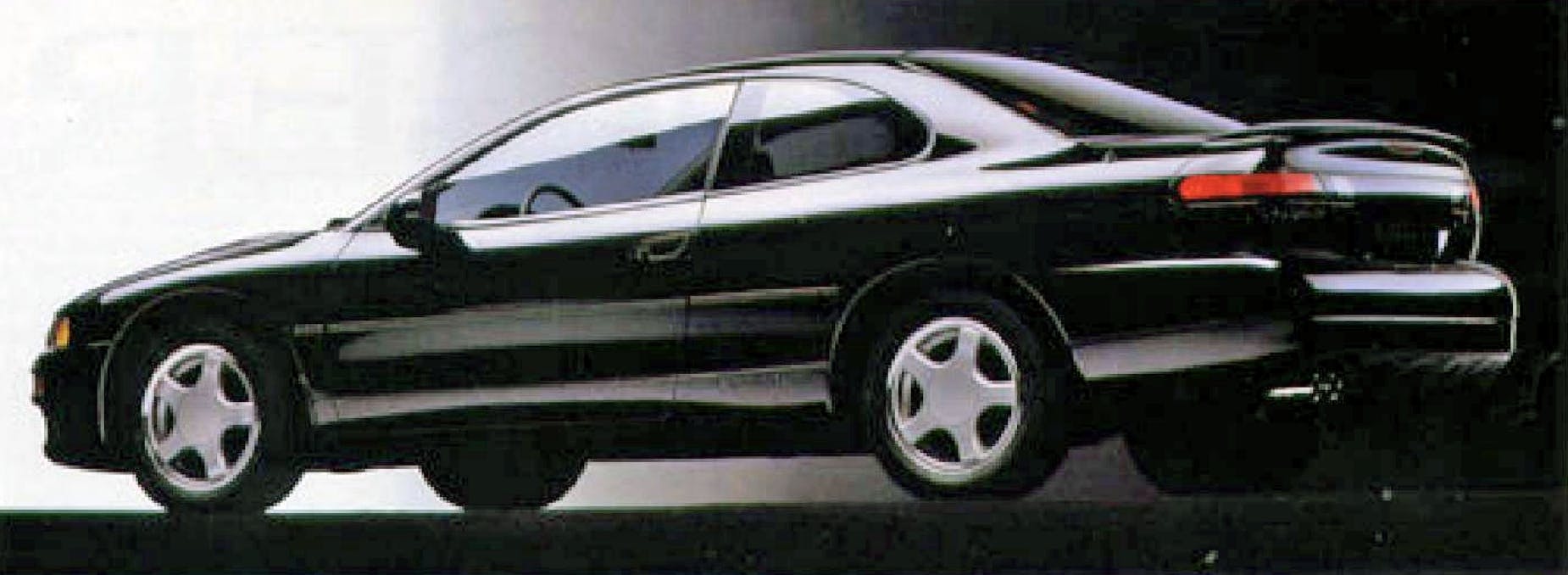When Chrysler tapped Mitsubishi to build a sporty coupe … for the third time
Chrysler could do little wrong in the 1990s, even if its good behavior feels, in hindsight, like a veneer that would be peeled away by its marriages with Daimler and Cerberus Capital Management. But Chrysler’s was a stylish and money-earning veneer, to be sure: The Dodge Ram had the face of a big rig, the LH-platform sedans had reversed the K-car’s staid stagnation, and the Viper was the ultimate halo vehicle.
Great investments bring great returns. In Taken for a Ride, an exposé of the Daimler “merger of equals,” Chrysler was reported to have earned over a billion dollars in the first quarter of 1998. Market share was at “an all-time high of 16 percent,” while profits per vehicle were nearly double those of Ford or General Motors. But there was still the matter of making a successor to the Dodge Daytona sports coupe. It could no longer utilize the G-body architecture, which had its roots in the now-defunct K-car platform. Chrysler needed something fresh and new in that segment, and the solution needed to be easy on the bottom line.

Looking inward apparently wasn’t an option: Chrysler was speeding up development times at a breakneck, tech-bro pace. Taken for a Ride noted that Chrysler fully embraced high-tech prototyping methods to “[build] only one prototype of its new 2.7-liter aluminum engine, where in the past it would have built as many as five.” That decision had yet to severely tarnish the LH-platform’s goodwill, but it shows how sensitive the company was to timeliness.
Chrysler wouldn’t make any money re-engineering the LH into a coupe. They used another automaker to make coupes in the recent past (here and here) so why not dip into that well a third time?
Ford’s bird was about to lose some thunder. Oldsmobile’s Cutlass might feel less supreme. Behold, Chrysler’s answer to personal luxury, with Mitsubishi guts, the face of a Viper, and a name that meant business: Avenger!

Indeed, the “all new” Dodge Avenger (and Chrysler Sebring) coupe added Chrysler-like swagger to a market of humdrum two-doors. The year was 1995, and Chrysler’s long history of platform- and powerplant-sharing with Mitsubishi continued apace, as the generally well regarded 6G73 Mitsubishi 2.5-liter V-6 mill found its way into the new Dodge Avenger and Chrysler Sebring. These four-seat touring coupes rode atop a Mitsubishi Galant–based FJ platform, assembled at Mitsubishi’s factory in Normal, Illinois.
You needn’t be a gearhead to appreciate the engineering interchangeability presented here: Just open the door and behold how even the Avenger’s dashboard was shared with the Mitsubishi Eclipse. Too bad that 6G73 mill wasn’t used in place of Chrysler’s half-baked 2.7 … but let’s get down to brass tacks about this cab-forward-era coupe.
The 1995 Chrysler Sebring is easily recognizable by the (optional) knock-off Mercedes monoblock wheels and the non-functional gunsight grille. (What was that about veneers and Chrysler management?) The Avenger avoids the atrocious fake grille via Dodge Viper–themed air inlets below the bumper. The Avenger’s posterior was heavily influenced by that of Dodge’s high-tech Stealth. All this performance DNA from the Dodge Boys made for a sleeker design.
That aesthetic is precisely why I chose to test-drive a Dodge Avenger ES as a study break when I was a sophomore in college. I certainly found the styling intriguing (sorry, Oldsmobile) and I knew the vehicle’s wrong-wheel-drive, Mitsubishi bones ensured I could make a purchase objection that no salesperson could overcome. As a courtesy, I decided to visit the dealer at an off-peak time and make my intentions for window-shopping crystal clear.
I enjoyed my Avenger test drive back then, just as I enjoyed Motorweek’s retro review today. The publication’s ES-grade tester was even finished in the same color as the one I sampled in college. Motorweek praises its long sports-coupe profile but notes the elongated wheelbase was more akin to a sedan. Or a Ford Thunderbird of the era, on second thought; but the Avenger is likely a tad more driver-focused than baseline models of the big Ford coupe.
Performance was adequate for the era, and Motorweek felt the Avenger would have a “wide range” of appeal across the sporty, touring-coupe market. It all sounds very Oldsmobilian, but the remains of the personal-luxury-coupe market were still a viable source of profit in the mid-1990s. Not for long, however—both the Avenger and Sebring ditched their coupe profile in forthcoming redesigns, for ample reason.
Back to my test drive as a college student. To the salesman’s credit, he did a great job promoting the Avenger ES’s wares—to someone who readily admitted they were more interested in an LT-1-powered Firebird or Camaro. Before I got behind the Avenger’s wheel, he parked at a scenic spot in the Texas hill country, handing me the keys as he pointed to the car’s Viper-inspired face, the parking lights menacingly glowing with anticipation. Not gonna lie, the Avenger’s exterior and interior styling felt (subjectively) superior to that of the compromised, fourth-generation F-body and the tall, portly SN-95 Mustang.
But I told him I was still leaning toward a Firebird Formula, as a flat passenger floorpan and a usable back seat were of little importance to a college student. He listened, then nodded in approval. The test drive did not end there, as he did an admirable job highlighting the Avenger’s highway-pulling power, fuel economy, and insurance costs savings over a V-8 pony car.
Not gonna lie, the Avenger was more fun than your average V-6 Thunderbird, and it had the looks of a smaller pony car. But once we got back to the dealership I muttered the words “Formula six-speed,” which made him come clean. Turns out the dude owned a 1993 Firebird Trans Am, and he loved it. He even recommended it to me over the Eagle Talons they had on the lot. Now that’s a refreshingly honest sales professional.
He instilled in me the notion of the Avenger’s superior style inside and out, even if its performance could never pass muster. The mandatory automatic bolted to Avenger’s Mitsubishi V-6 was the final nail in its coffin, and I reckon I was far from the only would-be buyer with those feelings.
I wonder if the Avenger coupe woulda faired better had it sported a powertrain akin to the outgoing Plymouth Sundance Duster. The Duster came with a Mitsubishi V-6 paired to a five-speed manual, resulting in performance figures that (according to Motorweek) were significantly faster than those of the Avenger in a straight line. For all the Avenger’s Viper- and Stealth-infused style, getting your butt handed to you by a Sundance Duster would be humiliating.
Even if I am right, a manual transmission wouldn’t save the entire personal-coupe genre. But it’s still a shame how quickly this body style came and went (1995–2000). It truly deserved better.
***
Check out the Hagerty Media homepage so you don’t miss a single story, or better yet, bookmark it. To get our best stories delivered right to your inbox, subscribe to our newsletters.






Speaking of the Duster, I had a 1992 Duster coupe, V6 with automatic. Maybe not quite as quick as a 5-speed version (which were hard to find used), but ample low-RPM torque gave it a lot of pep off the line. The handling was quite good for a FWD car of that era, the ride was decent, and the hatchback gave it much versatility.
The body style reminds me of the overall look of the Toyota Supra/Lexus SC300, as well as a few others typical of that era. Hated those rear “wing” things that seemed to be stuck on everything in the 90’s, but that long low coupe look is one I wish they had more of now.
The Starion / Conquest, the Eclipse / Talon / Laser and the 3000 GT / Stealth were great cars. The Avenger was not a great car.
These were sharp cars, but not as cool as the Daytona it replaced. They should have borrowed more than just the dash from the Eclipse.
Very well said. An Avenger R/T with AWD, turbo and a stick would be pretty amazing, even to this day.
I think there were (are?) a few builds on “the forums” (when such a thing was a thing) of 4G63-swapped Avengers. Maybe even an AWD example?
That wouldn’t surprise me one bit, considering there are turbo swapped Mitsubishi Expos out there, too.
In January of 1995, my Dad went down to the local Dodge Dealer and ordered a 95 Avenger Highline in Deep Green Pearl Metallic with the 2.0 4-cly and 4-speed automatic and ABS Brakes but no power windows, door locks, or cruise to be my sister’s first car. We had talked about it and she wanted an Eclipse or a Mustang but I would have to get a ride to school and be stuck in the back seat and wanted the bigger back seat of the Avenger. After looking at the Insurance rates for a 16-year-old on a new Mustang, the Avenger won the debate for my Dad, as the Insurance companies had not figured out how to price the Avenger yet and treated it like a sedan.
Around March the dealer called him and said the Deep Green Pearl paint was no longer an option for new builds so they would have to locate a car in Inventory for him instead. The dealer found the color but no ABS and with Power Windows and Locks etc. My sister was ecstatic as she really wanted the power options and could care less about ABS. The car came in April and she would get her license that August.
That summer we went on what became known as the “Road Trip from Hell” where the 4 of us took her Avenger on a 6 state tour. My Dad wanted to get her to practice driving and thought it would be good for her to do it in the car she would drive. Even with 2 weeks of luggage and 2 adults and 2 teenagers, we were very comfortable.
That Fall, when she went to School the parking lot, had several new Eclipses, Talons, and Mustangs and my sister had the ONLY Avenger so she was very glad she stuck out. That car went to College with her and eventually got traded in on her first car she bought on her own which turned to be a Red Mustang.
The first thing she said was “I finally got my Mustang” and the first thing my Dad said back to her and said “Wait till you see your Insurance Premiums”
Fantastic story, and it proves why the Avenger was a good car! Thanks for sharing.
A few details to add for this subject. The 2.0 4-cylinder was of Chrysler origin (same/similar as the Neon engine but different intake/exhaust configurations), and did feature a choice of 5-speed transmission, also Chrysler-sourced. The automatic with the V6 was Chrysler’s too. The engines sat longitudinally the opposite direction of the Mitsubishi engines (E-W Chrysler, W-E for Mitsubishi).
From 2001 MY the Avenger became the Stratus, still a 2 door coupe on the platform (wheelbase same) as the 1999 Galant 8G. This generation was powered completely with Mitsubishi engines and transmissions, 2.4 4-cylinder (4G64) and 3.0 V6 (6G72) , both available with 5 speeds and A/T versions. I own and still drive regularly a 2001 Stratus R/T manual. Almost 200k and still runs great. Did the timing belt, water pump, etc. service a few years ago. Replaced some exhaust and struts last year. Not bad for salty Michigan.
BTW, it’s 6G73, not G673. Cylinder count first. 😉
Oops, thanks for that, I have addressed the engine name mistake!
Oops, meant to say transverse, not longitudinally.
not the same vehicle but my daughter had I think a ’95 intrepid with the longitudinal engine. It was a great car and I loved the ease with which the engine could be maintained. always hated traverse mounted engines, especially V6’s.
The best way to order one of these was with the Chrysler 2.0 and the five-speed, which is what I had in my 1996 in prismatic purple-blue. It wasn’t slow, handled great, and I averaged 36.5 over the entire 100,000+ life of the vehicle. My final tank, prior to my neighbor slamming into it and totaling it as I slowly drove down my own street, was 40.4.
That adds up from what I considered during my test drive. It was a big coupe, but still small enough for a 4cyl and a 5-speed. Thanks for sharing, good to hear owner feedback on such an under appreciated car!